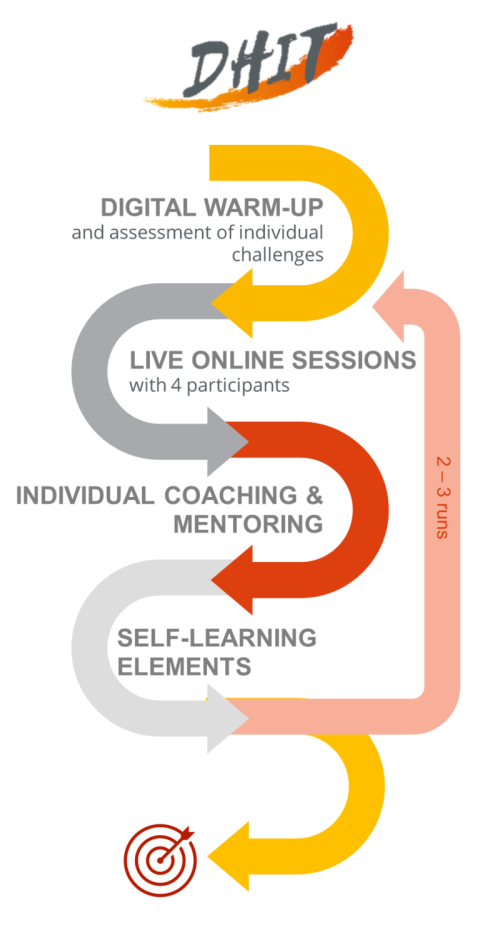Digital High Intensity Training
DHIT®: Leading with confidence
Rethinking leadership
The current times challenge you as a manager: You are back in the office, but you and your team continue to work on the move. Your communication with your employees is challenging, the cooperation is characterized by personal distance. Your team's commitment to common work goals has also declined - enthusiasm is nowhere to be found!

Digital High Intensity Training
DHIT®: Leading with confidence
Rethinking leadership
The current times challenge you as a manager: You are back in the office, but you and your team continue to work on the move. Your communication with your employees is challenging, the cooperation is characterized by personal distance. Your team's commitment to common work goals has also declined - enthusiasm is nowhere to be found!

4 participants
1:1 Mentoring
Intensive feedback
Sustainable Learning Journey
We are facing your personal challenges!
If any of that sounds familiar, we feel with you, and we know how to make things better. In this unique training format, we will develop solutions that are a custom fit for your individual challenges. We will give you the special tools you need to shine as a hybrid team hero. And we’ll reveal the steps you need to take to get your team back on the path of performance.
DHIT® stands for digital high intensity training. This compact format allows us to work very specifically on the special aspects of your individual situation. The restricted number of participants ensures an intense exchange with other team leads experiencing the same issues you are. In addition, it includes coaching sessions in which you will work to develop custom solutions. In this way, you develop a tailored action plan that you can put into practice straight away. As well, you benefit from personal coaching with your qualified trainer for your own personal development.
Your Learning Goals
- Understand your very individual challenges in everyday leadership and develop specific approaches to solving them
- Strengthen team cohesion as a leader, create more "we" feeling
- Dealing confidently with conflicts in the team as a leader
- Awakening enthusiasm for common goals and reaching employees better again
- Take into account new findings from science and futurology
- Understanding the different needs of employees and making collaboration attractive: in hybrid, virtual space and (back) in the office
- BANI Environment: Understanding and Managing Change Dynamics
- Designing a trusting work environment: virtual & hybrid
- Organize hybrid meetings professionally
Course description
With the Leadership Training, you strengthen your understanding of leadership and gain new perspectives through lively exchange in small groups and with the trainer.
With the help of Digital High Intensity Training, you can create an environment in which your team is happy to deliver top performance again.
We start with your challenges.
The DHIT® format allows you to work on your focus areas in a targeted manner and benefit from the exchange with the other participants. In the coaching sessions, the experienced Trainer:in also supports you in developing alternative courses of action. You will receive tailor-made solutions for your problems, which you can then implement on a 1-to-1 basis. In addition, the trainer supports personal growth through built-in coaching sessions.
Re-think and re-design your leadership because, in fact, nothing has stayed the same.
Your virtual has different requirements in 2023 than before and during the pandemic.
Design your hybrid settings more consciously and professionally now.
But your employees “back in the office” also have completely different expectations of the joint work on site and of you today.
You are free to choose whether you want to deal with your role as a leader, with change mechanisms or with the mechanisms of team development in this context. Or with a mix of these topic blocks.
show lessRe-think and re-design your leadership because, in fact, nothing has stayed the same.
Your virtual has different requirements in 2023 than before and during the pandemic.
Design your hybrid settings more consciously and professionally now.
But your employees “back in the office” also have completely different expectations of the joint work on site and of you today.
You are free to choose whether you want to deal with your role as a leader, with change mechanisms or with the mechanisms of team development in this context. Or with a mix of these topic blocks.
Most important facts about the course
- Actual situation of your everyday management and your personal challenges
- Strengthen your growth mindset in the BANI environment
- Active and attractive design options for hybrid, virtual and (back) in the office
- Successfully managing hybrid meetings
- How can you lead in a meaningful and motivating way
- Consider neuroscientific findings and future research
- Understanding employee needs and taking them into account individually
- Conflicts in the hybrid, virtual space and (back) in the office accompanied sovereignly
- Improve team cohesion and performance
Procedure of Digital High Intensity Training

Learning Journey
- 1,5 h Warm-up-Session
- 2x 3 h highly intensive and interactive live online sessions in small groups with max. 4 participants at intervals of approx. 1 week
- 2 individual 45 min. coaching sessions with your trainer following the live online sessions to support a successful transfer into individual practice
- Self-learning elements between the sessions to further support the learning process (time required approx. 3 hrs. in total)
All dates
02.09.2024
10:00 - 11:30
Live Online Session: Warm-Up
MS Teams
05.09.2024
09:00 - 12:00
Live Online Session: Module 1
MS Teams
12.09.2024
09:00 - 12:00
Live Online Session: Module 2
MS Teams
02.09.2024
10:00 - 11:30
Live Online Session: Warm-Up
MS Teams
05.09.2024
09:00 - 12:00
Live Online Session: Module 1
MS Teams
12.09.2024
09:00 - 12:00
Live Online Session: Module 2
MS Teams
Your Contact Person
Our experts will be pleased to advise you!


Your Contact Person
Our experts will be pleased to advise you!
Leading remote and hybrid teams: questions and answers
The answer to this question starts with choosing the right technology for your team. The choices you make should reflect how your team prefers to work. Look at how your team is keeping in touch and how often. Are the platforms you’ve chosen supporting you or hindering you in your work? It’s not just how you’re using chat, email, video conferences, but also how you do your task planning and where you store your working files and documentation.
First off, establishing trust is key. This is even more true in the remote world because of the different forms of communication. Where does trust come from? In the professional world, trust is strongly related to seeing that somebody knows how to do their job and that they consistently get that job done. So the question we would examine here is : Have you created the conditions that will allow your team members to be successful in their work?
Like so many other challenges in virtual and remote teams, the answer to this challenge would begin with getting things out in to the open with crystal-clear communication. Do you know what has gotten spirits down in the team? Or are you assuming that you know? Is there enough trust that people would tell you? The first step to breaking through in situations like this is to start with open, honest communication. By creating a space for respectful conversation where you are showing genuine interest in the concerns that obviously exist in the team, you make it possible for people to open up about the true issues. We will help you create an effective communications plan that fits your style.
The answer to this question starts with choosing the right technology for your team. The choices you make should reflect how your team prefers to work. Look at how your team is keeping in touch and how often. Are the platforms you’ve chosen supporting you or hindering you in your work? It’s not just how you’re using chat, email, video conferences, but also how you do your task planning and where you store your working files and documentation.
First off, establishing trust is key. This is even more true in the remote world because of the different forms of communication. Where does trust come from? In the professional world, trust is strongly related to seeing that somebody knows how to do their job and that they consistently get that job done. So the question we would examine here is : Have you created the conditions that will allow your team members to be successful in their work?
Like so many other challenges in virtual and remote teams, the answer to this challenge would begin with getting things out in to the open with crystal-clear communication. Do you know what has gotten spirits down in the team? Or are you assuming that you know? Is there enough trust that people would tell you? The first step to breaking through in situations like this is to start with open, honest communication. By creating a space for respectful conversation where you are showing genuine interest in the concerns that obviously exist in the team, you make it possible for people to open up about the true issues. We will help you create an effective communications plan that fits your style.


